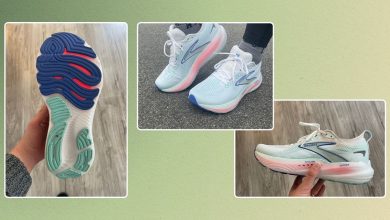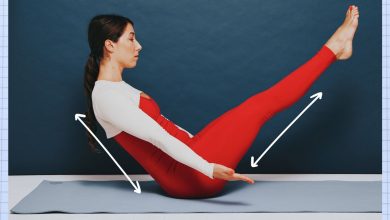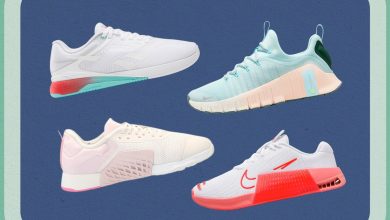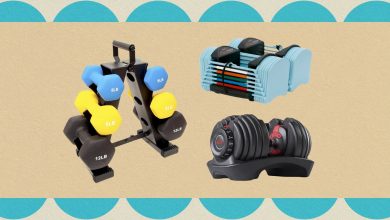Which Brooks Running Shoes Are Right for You? 11 Picks Podiatrists Trust
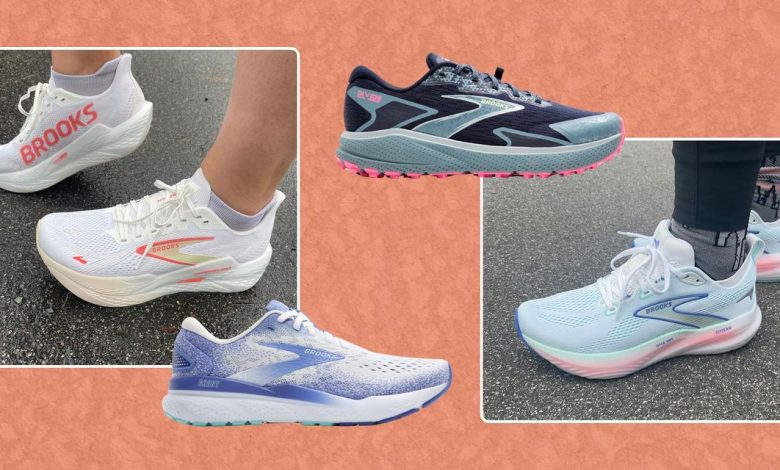
Brooks sneakers seem to pop up everywhere, with signature models like the Ghost on the feet of runners, walkers, grocery shoppers, nurses, travelers, and more. But it isn’t just the brand’s fun colorways that make them so popular—they’re also legit good-for-your-feet sneakers, loved by podiatrists and pedorthists. “From a doctor’s perspective, Brooks is kind of our go-to shoe,” Nicole Freels, FACPM, a certified pedorthist at Lexington Podiatry in Kentucky, tells SELF.
The only problem: How to choose from Brooks’s extensive lineup. To help you make your pick, we asked experts for their faves—plus advice on how (and when) to wear them—and logged some miles on a handful of pairs ourselves.
Our top picks
- Best Overall: Ghost 16
- Best for Walking: Addiction GTS 15
- Best Everyday Shoe: Ghost Max SE
- Best Daily Trainer: Glycerin 22
- Best for Overpronation: Adrenaline GTS 24
- Best for Plantar Fasciitis: Ariel GTS 24
- Best for Long Distances: Glycerin Max
- Best for Trail Running: Caldera 8
- Best for Speed Workouts: Hyperion Max 2
- Best for Road-to-Trail: Divide 5
- Best for Racing: Hyperion Elite 4 PB
What to consider when shopping for Brooks shoes
Sneakers generally fall into two categories: stability and neutral. Brooks shoes are no different—the brand’s GTS line features GuideRail technology for those who need extra stability, while classics like the Ghost and the Glycerin are great for folks with neutral arches.
Figuring out which type of shoe you need is key, certified running coach Laura Norris tells SELF. “Most runners only need neutral shoes, which don’t change your path of motion at all,” she says. “Runners who need stability shoes tend to be those who have issues like Achilles tendonitis, posterior tendonitis, or excessive changes in how their foot lands in their pronation.” If you’re not sure which type is right for you, getting a fitting and a gait analysis from a professional at a specialty running store can help.
Brooks offers a range of cushioning, with options for those who like to feel the ground, those who like a more pillowy feel, and everyone in between. The amount that’s right for you “comes down to comfort, how you land, and your body weight,” says Norris—all the more reason to try a shoe on in person before you buy (or to get familiar with Brooks’s return process, if there aren’t any retailers nearby).
Consider what you plan to be doing in your Brooks. If you enjoy sprints and speedwork, try an extra lightweight pair. Need a sneaker for your daily commute or weekend errands? Go one that’s more cushioned and supportive. Brooks has options for whatever you’re getting up to—as long as you know what you’re looking for.
Frequently asked questions about Brooks shoes
Do podiatrists recommend Brooks?
Yes: All of the podiatrists we spoke with recommend Brooks, and many of the brand’s shoes have been awarded a seal of acceptance by the American Podiatric Medical Association (APMA). “They’re always reliable, the quality is always there, and they’re very consistent with their materials,” Dr. Freels says.
Should I choose a do-it-all shoe or a more specialized shoe?
New runners or people who stand all day long can probably get away with investing in just one multipurpose shoe, according to Caroline Bermel, product marketing specialist and head shoe tester at Fleet Feet. But if you run regularly, she says there are lots of benefits to having a lineup of more specialized pairs. That’s because every shoe has a slightly different feel and level of support that will activate different muscles to keep your body feeling balanced, she explains.
“Another benefit is having the feel you want on that day—like how a golfer has different clubs,” Bermel says. For instance, if you’re chasing a new PR, you might want something lighter and faster. But during shorter jogs around the neighborhood, a cushier shoe could make your laps a little easier.
What are the best Brooks to buy?
The best Brooks model for you largely depends on your foot shape, your gait, your personal preferences, and how you plan to wear your shoes. “Remember, there’s no one best shoe,” Zach Thomas, DPM, a podiatrist at Performance Podiatry in Powell, Ohio, tells SELF. “There’s just the best shoe for your foot.”
Odds are, there’s a Brooks pair that’s right for you—and your feet. Find our top picks (and some shopping advice from the pros) below.
Best Overall: Ghost 16
Pros
- Fits a variety of foot shapes
- Awarded the APMA seal of acceptance
- Moderate, comfortable cushioning
Cons
- May not be enough padding for those who like a plush feel
The Ghost has long been a Brooks bestseller—and for good reason. While no one shoe is perfect for everyone, this one does have a Sisterhood of the Traveling Pants way of working for multiple foot shapes, John Dewey, PT, ATC, a certified athletic trainer, licensed physical therapist, and the owner of three Fleet Feet specialty running stores in North Carolina, tells SELF. (The fact that it also comes in narrow, wide, and extra wide widths helps too.)
The Ghost has a just-right heel stack, Bermel says: “It’s enough cushioning to provide support and impact absorption, but it’s not too much cushioning where you can’t feel the ground.” The result is a do-it-all shoe that works for everything from easy runs to cross-training to walking, she adds.
Having logged dozens of miles running in the Ghost 16 myself, I can attest that it lives up to its name—I can almost forget it’s there, in a good way. But it could be a downside for those who like a plush midsole. “If you’re looking for a little extra oomph or you want that bouncy feeling, the Ghost is probably not the shoe for you,” Bermel says. “It doesn’t have all the extra bells and whistles, but it’s functional, it gets the job done, and it’s comfortable.”
Original photo by SELF writer Lauren Wingenroth
Sizes: US 5 to 13 | Materials: Mesh, foam, rubber | Widths: Narrow, medium, wide, extra wide | Weight: 8.5 oz
Best for Walking: Addiction GTS 15
Pros
- Stable
- Durable
- Awarded APMA seal of acceptance
Cons
- Zero heel-to-toe drop may not work for everyone
The Addiction GTS 15 has everything that Dr. Thomas looks for in a walking shoe: solid stability and great durability. He often prescribes the Addiction for patients looking for pain relief, thanks to the shoe’s GuideRail technology (a.k.a. GTS) that’s designed to prevent overpronation or oversupination. In other words, it keeps your feet aligned correctly so your ankles can’t roll inwards or outwards as you walk. We also like that the shoe’s extra-roomy toe box is designed to accommodate orthotics or insoles, if you need some more support.
Sizes: US 5 to 12 | Materials: Mesh, foam, rubber | Widths: Narrow, medium, wide, extra wide | Weight: 12.9 oz
Best Everyday Shoe: Ghost Max SE
Pros
- Similar to the Ghost 16, but with more cushioning and a lower heel-to-toe drop
- Great shock absorption
- Stylish suede upper
Cons
- High stack may be too unstable for some
- Only comes in one width
When Dr. Freels has a long work day, the Ghost Max “is the only shoe I’ll wear,” she says. “I really am a huge fan—I don’t hesitate recommending it to anybody, honestly.” She says the shoe’s high stack of cushioning is great for shock absorption, especially for those who stand on hard surfaces all day, like health care professionals. It’s also her go-to for treadmill running.
Bermel adds that she loves how cool the suede upper looks—she’s also a fan of the sleek leather version, which is a great candidate for everyday wear.
Sizes: US 5 to 12 | Materials: Mesh, suede, foam, rubber | Widths: Medium | Weight: 10 oz
Best Daily Trainer: Glycerin 22
Pros
- Plush yet responsive cushioning
- Great energy return
- Smooth, comfortable ride
Cons
- On the heavy side
In the not-so-distant past, runners looking for one do-it-all trainer had to choose between a softer, more cushioned shoe (easy on the body, but sometimes clunky and slow) and a snappy, more responsive one that can pick up the pace (at the cost of feeling too thin underfoot). But the new Glycerin 22 has the best of both: a nitrogen-infused midsole with squishier padding in the heel, where most runners land, and a firmer forefoot for easier push-offs.
When I tested the Glycerin 22s nearly every day, I wore them during easy runs and workouts on the road and the treadmill. My pair held up: Although the shoes don’t feel as space-age as they sound, I found that whether I was going slowly or picking up the pace, they struck the right balance of soft and springy. (You can read my full review here.)
Dr. Freels is also impressed by the pair’s tech and says that the sneaker’s combo of cushiness and energy return “is going to put your body in a better position long-term during the gait cycle.”
Sizes: US 5 to 12 | Materials: Jacquard knit, foam, rubber | Width: Medium, wide, extra wide | Weight: 9.1 oz
Best for Overpronation: Adrenaline GTS 24
Pros
- Guardrails provide stability for mild-to-moderate overpronation
- Breathable mesh upper
- Moderate, soft cushioning
Cons
- May not be enough padding for running longer distances
- Some Brooks reviewers say it runs small
The Adrenaline is Brooks’s signature stability, or GTS, shoe, and one of the most popular options for overpronators. It’s made with the brand’s GuideRail technology, a.k.a. plastic reinforcements, on each side of the shoe that you can think of like bumpers at a bowling alley, says Bermel. “They aren’t meant to change the way that you move,” she says. “It’s more to offer support to runners who overpronate, so that their shoes don’t wear out unevenly, because that can cause issues down the road.”
Lee Firestone, DPM, a podiatrist at Foot & Ankle Specialists of the Mid-Atlantic and an avid runner, can personally vouch for the Adrenalines. “I’m a pronator,” he tells SELF. “I think they’re well-made shoes, and the GuideRails really do help with stability for people who have pronation, like me.”
Sizes: US 5 to 13 | Materials: Mesh, foam, rubber | Widths: Narrow, medium, wide, extra wide | Weight: 8.8 oz
Best for Plantar Fasciitis: Ariel GTS 24
Pros
- Extremely stable
- Also great for correcting overpronation
- Awarded the APMA seal of acceptance
Cons
- Heavy
When a patient has plantar fasciitis, the odds are good that Dr. Thomas will recommend the Ariel GTS 24. “Overwhelmingly, the Ariel is one of the most common shoes I prescribe for plantar fasciitis,” he says. “It’s just so darn stable in the rear foot.”
That stability is key for those with plantar fasciitis, he explains, because any movement from your foot wiggling around in your shoe during your gait cycle can irritate your plantar fascia even more. “Something like the Ariel that has the two pieces of plastic on either side and a wider base is going to stop that toggling back and forth,” Dr. Thomas says.
Sizes: US 6 to 13 | Materials: Mesh, foam, rubber | Widths: Medium, wide, extra wide | Weight: 11.1 oz
Best for Long Distances: Glycerin Max
Pros
- Lots of soft, bouncy cushioning
- Softer foam in the heel and more responsive foam in the forefoot
- Rocker shape for smooth transitions
Cons
- Max cushioning will be too much for some runners
- Heavy
“I know for me, and for a lot of runners, they like to have some extra cushioning underfoot when they’re going to be on their feet for a long time,” Bermel says. The Glycerin Max has all that cushioning and then some—a whole 45 millimeters, to be exact.
When SELF’s director of food and fitness, Christa Sgobba, CPT, tested a pair, she found that they helped save her legs from the pounding of long marathon training runs. “On those days, I’ve been particularly grateful to reach for the Glycerin Max—they really provide that extra dose of TLC to help you get through that day’s plan,” she wrote in her review.
Bermel agrees: “I like it for long runs because it’s got cushion and bounce, but it’s not too soft, so I feel like I can still run at a decent pace,” she says. That said, she acknowledges that the amount of cushioning can feel clunky. “It’s not a shoe where you could have a sense of ground feedback, which some runners really like,” she says.
Original photo by SELF writer Lauren Wingenroth
Sizes: US 5 to 12 | Materials: Mesh, foam, rubber | Widths: Medium | Weight: 9.5 oz
Best for Trail Running: Caldera 8
Pros
- Wide base for stability
- Quick-drying upper
- Durable, grippy outsole
Cons
- Some runners may want less cushioning on uneven trails
- Only available in one width
What works on the roads doesn’t always work on the trails. A solid trail shoe should have deep lugs on the outsole (like treads on a tire) for grip, a wider base for extra stability on ever-changing terrain, and a protective upper that won’t snag on roots and rocks. The Caldera 8’s got it all—and it’s supercomfortable, Dr. Thomas says.
“On a trail, a lot of times your gait is not uniform because you’re avoiding things like ruts,” he says. “Having a wider midfoot and a wider heel is a game changer because it can introduce a lot more stability—that’s why I like the Caldera.”
Norris adds that the Caldera is a favorite of many of her trail athletes. “It’s very cushioned and supportive—you have enough protection, but you also have good response, so you don’t feel like you’re being weighed down by your shoe,” she says. “It’s pretty nimble and responsive for a trail shoe.”
Sizes: US 5 to 12 | Materials: Mesh, foam, rubber | Widths: Medium | Weight: 8.3 oz
Best for Speed Workouts: Hyperion Max 2
Pros
- Rocker and plate make for speedy transitions
- Breathable, comfortable upper
- Propulsive, protective foam
Cons
- Only available in one width
I don’t necessarily recommend slipping a brand new running shoe on out of the box and going for an 11-mile run. However, that’s what I did when the Hyperion Max 2 landed on my doorstep—and I have no regrets. I was already planning on doing a long run with a few sections of marathon-pace efforts, and I had a feeling that this shoe would make me feel fast in the beginning and get me through the final stretch when my legs would be tired.
I was right on both counts. The shoe’s SpeedVault plate (which is similar to the carbon plates in many marathon racing shoes) pushed me forward, and the highly cushioned heel helped make those later miles easier.
Original photo by SELF writer Lauren Wingenroth
Sizes: US 5 to 12 | Materials: Mesh, foam, rubber | Widths: Medium | Weight: 8.3 oz
Best for Road-to-Trail: Divide 5
Pros
- Versatile enough for a variety of terrain
- Budget-friendly
- Wide, stable base
Cons
- Feels a bit firm on the roads
- Only for light-to-moderate trails
With a hybrid shoe like the Divide 5, you’ll be prepared for almost anything—including taking your run off the roads. It’s durable and protective enough for light trails, but not so heavy that it feels clunky on the pavement (which true trail shoes often do).
Dr. Thomas likes its wide, stable base, but emphasizes that it’s probably not the best choice for more technical trails or for logging more than a few road miles at a time, since the lugs will wear out quickly on asphalt.
Sizes: US 5 to 12 | Materials: Mesh, foam, rubber | Widths: Medium | Weight: 8.9 oz
Best for Racing: Hyperion Elite 4 PB
Brooks
Hyperion Elite 4 PB
Pros
- Propulsive carbon fiber plate
- Easier to wear than other, more aggressive racing shoes
- Responsive foam midsole
- Comfortable, breathable upper
Cons
- Not intended for beginners or slower paces
If you’re training to hit a PR—whether you’re running a 5K or a marathon—the Hyperion Elite 4 PB is your best Brooks bet. (The PB in the name actually refers to the PEBA foam in the midsole, but we can pretend it means “personal best”.) This is the shoe that Brooks’s elite athletes (like Des Linden!) sport during their races, and Norris says it’s pretty approachable for recreational runners too.
“Some carbon-plated shoes are very aggressive—they have intense rockers and they can sometimes be a little too much for your middle-of-the-pack or back-of-the-pack runners,” she says. “The geometry of the Hyperion Elite makes it more accessible for runners running 8-, 9-, or 10-minute miles.”
Sizes: US 6.5 to 13.5 | Materials: Mesh, PEBA foam, carbon plate, rubber | Widths: Normal, wide | Weight: 7.2 oz
Related:
- The Right Weightlifting Shoes Can Improve Your Power and Form—Here Are 13 Expert-Approved Picks
- 12 Best Insoles for Flat Feet, According to Podiatrists
- 9 Comfy, Supportive Shoes Podiatrists Swear by for Back Pain
Get more of SELF’s great product recommendations delivered right to your inbox (for free!).
